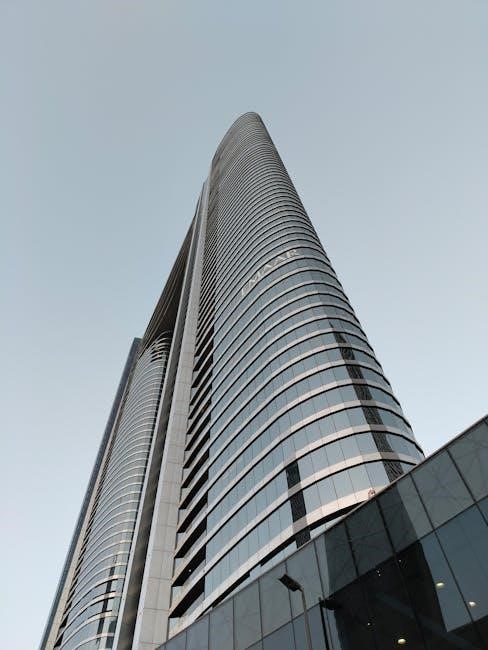Blade HQ’s Steel Guide is a trusted resource for knife enthusiasts, offering detailed insights into various steel types, their properties, and applications, helping users make informed decisions․
1․1 Overview of Blade HQ and Their Steel Guide
Blade HQ is a renowned retailer specializing in high-quality knives and accessories, catering to both enthusiasts and professionals․ Their Steel Guide is a comprehensive resource designed to educate users on various types of knife steels, their properties, and applications․ The guide provides detailed information on carbon steels, stainless steels, tool steels, and alloy steels, among others․ It emphasizes the importance of understanding steel characteristics such as hardness, corrosion resistance, and toughness․ Blade HQ’s Steel Guide is widely regarded for its clarity and accessibility, making it a valuable tool for both newcomers and experienced knife users․ By offering insights into the pros and cons of different steels, the guide helps individuals make informed decisions when selecting knives for specific purposes․
1․2 Importance of Understanding Knife Steel
Understanding knife steel is crucial for selecting the right tool for specific tasks․ Different steels offer varying levels of hardness, corrosion resistance, and durability, impacting performance․ Blade HQ’s guide highlights these factors, helping users choose knives that meet their needs․ Whether for everyday carry, outdoor activities, or professional use, knowing the steel’s properties ensures optimal functionality and longevity․ Ignorance of steel types can lead to poor performance or premature wear․ Blade HQ’s guide bridges this knowledge gap, empowering users to make informed decisions and enhance their knife-owning experience․ By focusing on steel’s role in a knife’s functionality, the guide emphasizes the significance of material quality in determining overall utility and satisfaction․ This understanding fosters a deeper appreciation for craftsmanship and enhances user confidence in their selections․

Common Types of Knife Steel
Knife steels are categorized into carbon, stainless, tool, and alloy steels, each offering unique properties like hardness, corrosion resistance, and durability, as detailed in Blade HQ’s guide;
2․1 Carbon Steels (e․g․, 1095, 15N20)
Carbon steels, like 1095 and 15N20, are renowned for their exceptional hardness and edge retention, making them ideal for high-performance knives․ These steels contain higher carbon content, which enhances their ability to hold a sharp edge but may sacrifice some corrosion resistance․ Blade HQ’s guide highlights that 1095, a popular choice among knife enthusiasts, is often used in survival and outdoor knives due to its durability and ease of sharpening․ On the other hand, 15N20, with its nickel content, offers improved toughness and is frequently used in Damascus steel patterns for its striking visual appeal․ While carbon steels require more maintenance to prevent rust, their superior performance makes them a favorite for those prioritizing cutting efficiency․ Blade HQ’s Steel Guide provides detailed comparisons and recommendations for users considering carbon steel knives․
2․2 Stainless Steels (e․g․, 420HC, S30V)

Stainless steels, such as 420HC and S30V, are highly valued for their excellent corrosion resistance and durability, making them ideal for knives exposed to harsh environments․ 420HC, a mid-range stainless steel, is widely used in everyday carry knives due to its balance of affordability, ease of sharpening, and resistance to rust․ S30V, on the other hand, is a premium stainless steel known for its exceptional hardness and edge retention, thanks to its vanadium and chromium content․ While stainless steels may lack the edge retention of high-carbon steels, they are more forgiving in wet or salty conditions, making them a practical choice for marine or outdoor applications․ Blade HQ’s guide emphasizes that stainless steels like S30V are particularly favored by knife enthusiasts who prioritize both performance and low maintenance․ These steels are versatile and suitable for a wide range of knife styles and uses․
2․3 Tool Steels (e․g․, D2, M390)

Tool steels, such as D2 and M390, are renowned for their exceptional hardness, wear resistance, and ability to hold a sharp edge, making them ideal for high-performance knives․ D2, a high-carbon tool steel, is prized for its toughness and resistance to abrasion, though it can be more challenging to sharpen due to its hardness․ M390, an advanced tool steel, combines high hardness with excellent corrosion resistance, thanks to its high chromium content․ Both steels are often used in premium knives designed for demanding tasks․ Blade HQ’s guide highlights that tool steels like M390 are favored by professionals and enthusiasts who need a blade that can withstand heavy use without losing its edge․ While they may require more maintenance than stainless steels, their durability and performance make them a top choice for serious knife users seeking high-quality craftsmanship․

2․4 Alloy Steels (e․g․, 154CM, S35VN)
Alloy steels like 154CM and S35VN are highly regarded for their balanced properties, combining hardness, corrosion resistance, and toughness․ 154CM, a popular choice for EDC knives, offers excellent edge retention and durability, while being relatively easy to sharpen․ S35VN, an advanced alloy steel, is known for its superior wear resistance and corrosion resistance due to its high chromium and vanadium content․ Both steels are widely used in high-quality knives, as they strike a balance between performance and practicality․ Blade HQ’s guide emphasizes that alloy steels like these are ideal for users seeking a versatile knife that can handle both everyday tasks and more demanding applications․ Their ability to maintain a sharp edge and withstand corrosion makes them a favorite among knife enthusiasts and professionals alike․

Key Properties of Knife Steel

Understanding knife steel properties like hardness, corrosion resistance, and toughness is crucial for selecting the right blade, ensuring optimal performance, durability, and edge retention for various applications and environments․

3․1 Hardness and Edge Retention
Hardness is a critical factor in knife steel, directly influencing edge retention․ Measured on the Rockwell scale, higher hardness levels typically result in better edge retention but may compromise toughness․ Blade HQ’s guide emphasizes that steels like S30V and M390, known for their high hardness, excel in retaining sharpness, making them ideal for high-performance applications․ However, overly hard steels can be more prone to chipping․ The balance between hardness and toughness is essential, as it determines the knife’s longevity and usability across different tasks․ Understanding this property helps users choose the right steel for their specific needs, whether for everyday carry, outdoor use, or professional tasks․ Blade HQ’s guide provides detailed comparisons and recommendations to aid in this decision-making process․
3․2 Corrosion Resistance and Durability
Corrosion resistance and durability are vital factors in knife steel, especially for knives used in harsh or wet environments․ Stainless steels, such as 420HC and S30V, are renowned for their ability to resist rust and corrosion due to their high chromium content․ Blade HQ’s guide highlights that these steels are often preferred for everyday carry and marine applications․ On the other hand, high-carbon steels like 1095 offer exceptional durability but may require more maintenance to prevent corrosion․ The guide also notes that modern alloy steels, such as S35VN, strike a balance by combining high hardness with improved corrosion resistance․ Proper steel selection ensures longevity and performance, making Blade HQ’s guide an invaluable resource for users seeking durable and low-maintenance knives․ Understanding these properties helps enthusiasts choose the best steel for their lifestyle and usage demands․

3․3 Toughness and Wear Resistance
Corrosion resistance and durability are vital factors in knife steel, especially for knives used in harsh or wet environments․ Stainless steels, such as 420HC and S30V, are renowned for their ability to resist rust and corrosion due to their high chromium content․ Blade HQ’s guide highlights that these steels are often preferred for everyday carry and marine applications․ On the other hand, high-carbon steels like 1095 offer exceptional durability but may require more maintenance to prevent corrosion․ The guide also notes that modern alloy steels, such as S35VN, strike a balance by combining high hardness with improved corrosion resistance․ Proper steel selection ensures longevity and performance, making Blade HQ’s guide an invaluable resource for users seeking durable and low-maintenance knives․ Understanding these properties helps enthusiasts choose the best steel for their lifestyle and usage demands․
Blade HQ’s Steel Guide provides essential insights, helping users understand steel types and properties․ It empowers enthusiasts to make informed decisions, ensuring the perfect knife for their needs and preferences․

4․1 Final Thoughts on Choosing the Right Steel
Selecting the right knife steel is crucial, as it determines performance, durability, and maintenance․ Blade HQ’s guide simplifies this process by breaking down steel types and their properties․ For everyday carry, stainless steels like 420HC or S30V are ideal due to their corrosion resistance․ For outdoor or heavy-duty use, high-carbon steels such as 1095 or D2 offer exceptional hardness and edge retention․ Professionals may prefer alloy or tool steels like M390 or S35VN for their balance of toughness and wear resistance․ Ultimately, the choice depends on the user’s lifestyle, preferences, and intended use․ Blade HQ’s comprehensive guide ensures enthusiasts can make informed decisions, whether they’re seeking reliability, affordability, or premium performance․ With so many options available, understanding steel characteristics is key to finding the perfect knife for any need․
